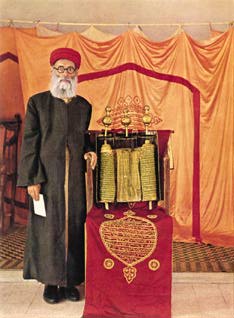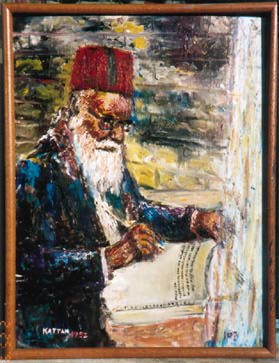The Samaritans
The Samaritans
are a small tribe, totalling about 1,000 people, who live
mostly in the town of Nablus (Shechem) on the steps of Mt.
Gerisim, or in Holon, Israel. They trace themselves to the
remnants of the tribes of Ephraim and Manasseh with an admixture
of non-Israelite colonists transported by the Assyrians after
the defeat of the Kingdom of Israel in 721 B.C.E. and deportation
of the Ten Tribes of Israel.
The function of
High Priest (Cohen) is carried out by a Levite descendant.
The position is not hereditary but passes on to the eldest
member of the Priestly family. The tribe suffered most from
attacks by the Arabs who looted much of their ancient books
and treasures.
The Samaritans
claim that their tradition has not changed for over 3,000
years. The Samaritan religion is composed of the following
beliefs:
1. The Lord is
the one and only God and there is none beside him.
2. The only prophet
is Moses and no other prophet was or will be beside him.
3. The only Holy
Book is the "Torah" consisting of the Five Books of Moses
and the Book of Joshua.
4. The belief
that the only Holy place in the world is Mt. Gerizim the Blessed
Mountain, not Jerusalem - the Holy place of the Jews.
5. The Day of
Judgement of the Lord will be according to the laws of the
Torah, then every man will be judged and punished for his
sins.
The Samaritans
have seven holidays:
1. The first
festival is the Passover. This feast begins in the middle
of the first month (the month of Nisan) which is considered
the first month of the year. During this feast all the tribe
mounts up to the Blessed Mountain, Mt. Gerizim and remain
there all during the Passover holiday. The first evening of
the holiday, the 14th of the month, all the tribe celebrates
the Passover sacrifice on Mt. Gerizim while many outsiders
and tourists watch as bystanders. The clothing of the Samaritans
during the sacrifice should be all white, reminding them of
the Israelites' clothing when they left Egypt.
The time for eating
the sacrifice is after midnight. At that time the meat is
ready for eating and has been well roasted and prepared previously,
especially for the occasion. The Sacrifice is eaten in accordance
with the Commandment of the Old Testament - "belts round thy
loin, thy shoes on thy feet and thy staff in thine hand, and
thou shalt eat it in haste for it is the Passover of the Lord."
All the days of the Passover the tribe eats only unleavened
bread, which is prepared by the tribe, cooked on ashes.
2. The feast
of the unleavened bread is on the last day of the Passover.
On that day, all the tribe mounts up the mountain to the highest
peak. There, an altar stands, on the same place where it was
said Abraham had built his own altar to give his son Itzhak
up to the Lord, when the Lord wanted to try AbrahamĂs faith.
Each one of the tribe kisses the side of this alter asking
the Lord for all he or she wishes.
3. The feast
of Shavuoth is counted exactly 50 days after the first Sabbath
of Passover, thus it always happened on a Sunday (cf. Whit
Sunday). Formerly, the tribe used to bring the High Priest
the first of their yield from the field, and a tenth of the
wheat according to the laws of the Torah. Nowadays, the High
Priest is given money which he divides among the members of
the priestly family.
4. The first
day of the seventh month (Tishrei) is the beginning of the
ten days of repentance. On this day they feast and pray until
midday. However, this day is not called the New Year (Rosh
Hashana).
5. The Day of
Kippurim is on the tenth day of the seventh month. On this
day, all the tribe fasts, including the animals of the tribe.
This fast is accompanied by a prayer which does not stop day
and night for 26 hours. On this day the Holiest Scroll, the
most ancient Bible in the world is taken out and shown to
the whole tribe - this is the Torah written on a skin, in
the Ohel Moed by the high Priest Avishua Ben Pinchas, the
great-grandson of Aharon, brother of Moses. This Scroll is
found until today in the hands of the tribe.
6. The feast
of the Tabernacles falls on the fifteenth day of the seventh
month. This feast is a reminder of the time when the children
of Israel stayed in booths on their way from Egypt to Israel.
This feast lasts seven days. As from the first day, each family
builds a booth in the house in one room of the house. This
made by four poles up to the ceiling, then poles crosswise.
On these poles a net is placed laden with seasonal fruits
and covered with Eucalyptus branches. During all this time
the families try to be always under the booth, eating their
meals there and receiving their guests there.
7. "Rejoicing
of the Torah" is the eighth day of the Tabernacle Feast. The
prayer at this time is one of the longest of the whole year
(10 hour continuous prayer which goes on until 12 o'clock
mid-day). When night falls, all the families tear down their
booths, and make great bonfires out of the wood that has in
the meantime grown dry in their homes.
The older Priests
wear a red turban and a long gown (see picture). This way
of clothing started 700 years before the Exodus. However,
on Saturdays, holidays and during prayers, the Priests wear
white turbans.
The new born baby
is circumcised only on the eighth day - not before or after.
That is why the circumcision is always planned for the early
morning hours, so that it may not be postponed for any reason
even until the second day. The circumcision is even carried
out on Saturday or "Kippurim" should the eighth day fall on
same.
According to the
tradition, the "Torah" was given to the children of Israel,
by Moses Ben-Amran, in the year 2194 after the world existed
(1566 B.C.E.) 40 years after the exodus of the children of
Israel from Egypt, from slavery.
During the day,
two prayers are held, one at dawn lasting a few minutes and
one at nightfall also a few minutes but can be lengthened
by adding all sorts of passages to it. While praying, one
stands, bows and kneels. All the prayers in the tribe should
be held in the maximum of cleanliness. Each prayer starts
only after each hath washed his face, hands, feet, ears, nose
and mouth in water three times each. The person who prays
is not allowed to wear shoes, and stands on a special carpet.
The Samaritan
Holy Scroll was written in the original Hebrew alphabet which
was used by our ancestors until the days of Ezra the Scribe
when the writing was changed to the modern square Hebrew alphabet.
Some say that he did so to confuse the Samaritans. At the
end of the Samaritans ancient Scroll is written the following:
"I, Avishua,
son of Pinhas, son of Eliezer, son of Aharon the Cohen,
Peace be with you, I have written this Testament on the
porch of the Holy Tent, on Mt. Gerizim, in the thirteenth
year after the children of Israel have entered the country
of Canaan. I thank the Lord.
In the State of
Israel they are recognised as an independent religious community.
THE GOOD SAMARITAN:
When Jesus spoke
of the good Samaritan he did not mean to praise that group
of people. On the contrary, what he meant was, that even a
Samaritan who believes correctly and comes to the rescue of
someone in need of help, is to be commended.

Above: A Samaritan
priest with the famous Scroll said to be written over 3,000
years ago, 12 years after the children of Israel entered
Canaan.

The above picture
of the writer's great-grandfather, Abraham, who was a scribe
of Torah Scrolls and who also was "bodeq" checking
the writing of other scribes. The picture was painted by
the author from memory.
If
you would like to make any comments or contribute to The
Scribe please contact
us.
|